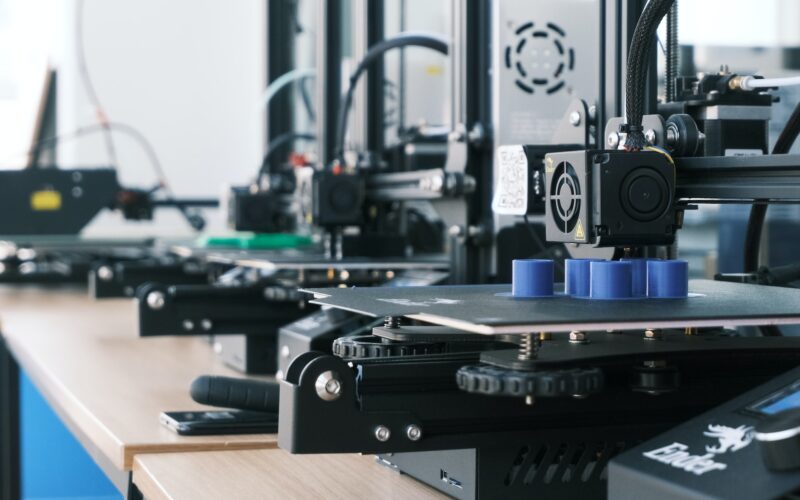3D printing, also known as additive manufacturing, has revolutionized the way we create and manufacture objects. This technology allows for the creation of three-dimensional objects from digital designs, by layering materials such as plastic, metal, or even living cells. In recent years, 3D printing has gained popularity in various industries, from aerospace and automotive to healthcare and education.
Advancements in 3D printing technology have led to faster printing speeds, increased precision and accuracy, and larger printing capabilities. Moreover, new materials are being developed that offer unique properties, such as biocompatibility and conductivity, expanding the range of objects that can be created using 3D printing.
The importance of these advancements cannot be overstated. They have the potential to transform manufacturing processes, making them more efficient and sustainable. 3D printing also has the potential to revolutionize healthcare by enabling the creation of personalized medical devices and even human organs. Furthermore, 3D printing offers a way to reduce waste and lower the carbon footprint of manufacturing processes, as it allows for the creation of objects on demand, without the need for mass production and shipping.
In this article, we will explore the latest developments in 3D printing technology, including advancements in materials, speed and precision, size, and accessibility. We will also discuss emerging 3D printing technologies and their potential future applications. Finally, we will examine the challenges and limitations facing 3D printing and the potential impact of this technology on various industries.
Materials
The materials used in 3D printing are evolving rapidly, with new materials being developed regularly to offer unique properties and capabilities. Materials such as plastics, metals, ceramics, and even living cells can be used in 3D printing, enabling the creation of a wide range of objects.
One recent development in 3D printing materials is the emergence of composites. These materials combine two or more materials with different properties to create a hybrid material that offers the best of both worlds. For example, carbon fiber-reinforced plastics (CFRP) are lightweight, strong, and stiff, making them ideal for use in aerospace and automotive industries. Similarly, metal matrix composites (MMCs) combine the strength and stiffness of metal with the lightness of other materials, making them ideal for use in engineering and manufacturing.
Another recent development in 3D printing materials is the emergence of biocompatible and bioresorbable materials. Biocompatible materials are materials that can be safely implanted in the human body without causing an immune response. Bioresorbable materials are materials that can be absorbed by the body over time, reducing the need for additional surgeries. These materials have the potential to revolutionize the medical industry by enabling the creation of personalized medical devices, such as implants and prosthetics.
Advancements in material science have also led to the development of conductive materials, such as graphene and carbon nanotubes, which can be used to create objects with electronic components embedded in them. This opens up new possibilities for creating electronic devices, such as sensors and displays, using 3D printing technology.
However, there are still limitations to the materials used in 3D printing. For example, the strength and durability of printed objects can be limited by the properties of the materials used. Furthermore, some materials can be difficult to print with, requiring specialized equipment or techniques. Additionally, the cost of materials can be high, especially for specialty materials.
Despite these limitations, the development of new and improved materials for 3D printing is opening up new possibilities for the technology, allowing for the creation of more complex and functional objects than ever before.
Speed and Precision
Advancements in 3D printing technology have led to significant improvements in both printing speed and precision, allowing for the creation of more complex and intricate designs.
One recent development in 3D printing speed is the use of continuous liquid interface production (CLIP) technology. CLIP technology uses a liquid resin that is cured by light to create objects, allowing for faster printing speeds than traditional layer-by-layer printing methods. This technology can create objects up to 100 times faster than traditional 3D printing, making it ideal for use in the production of large-scale objects.
Advances in precision have also been significant in recent years, allowing for the creation of objects with intricate designs and complex geometries. High-resolution 3D printers are now capable of printing objects with layer heights as small as 10 microns, allowing for the creation of objects with incredibly fine details. Furthermore, new software and algorithms are being developed that enable printers to make adjustments on-the-fly, ensuring that objects are printed with the highest level of precision and accuracy.
Precision is especially important in fields such as healthcare and engineering, where objects need to fit together precisely and function properly. For example, in the medical field, 3D printing can be used to create personalized implants that are custom-fitted to a patient’s unique anatomy. In engineering, 3D printing can be used to create prototypes and test parts quickly and efficiently, allowing for faster design iterations and better final products.
However, there are still limitations to printing speed and precision. For example, the speed and precision of 3D printing can be affected by factors such as the complexity of the object being printed, the size of the printer, and the materials used. Additionally, some printing methods may not be suitable for certain types of objects or materials.
Despite these limitations, advancements in speed and precision have significantly improved the capabilities of 3D printing, allowing for the creation of more complex and functional objects than ever before. As technology continues to improve, it is likely that we will see even greater improvements in 3D printing speed and precision in the future.
Size
One of the most exciting recent developments in 3D printing technology is the ability to print larger objects. Traditional 3D printers have size limitations based on the size of the printer bed and the mechanics of the printing process. However, new advancements in 3D printing technology have allowed for the creation of larger printers and new printing techniques that can print larger objects.
One way that larger objects can be printed is through the use of gantry-style printers, which are designed to print on a larger scale. These printers can be used to print objects that are several meters long, such as airplane wings and large-scale sculptures. These printers use a system of rails and pulleys to move the print head around, allowing for greater flexibility in the size of the objects that can be printed.
Another method of printing larger objects is through the use of robotic arms. Robotic arms can be programmed to print objects on a larger scale, allowing for greater precision and flexibility in the printing process. This method is especially useful for printing objects that have irregular shapes or require a lot of detail, such as architectural models or sculptures.
Large-scale 3D printing has practical applications in a variety of industries, such as construction and architecture. For example, 3D printing can be used to create large-scale building components such as walls and columns, which can then be assembled on site. This method can be faster and more cost-effective than traditional construction methods, while also allowing for greater design flexibility.
However, there are still limitations to the size of objects that can be printed. Printing larger objects can require specialized equipment and materials, and can be more time-consuming than printing smaller objects. Additionally, printing larger objects can be more prone to errors, such as warping and cracking.
Despite these limitations, advancements in large-scale 3D printing are opening up new possibilities for the technology, allowing for the creation of larger and more complex objects than ever before. As the technology continues to improve, it is likely that we will see even greater advancements in large-scale 3D printing in the future.
Accessibility
One of the most significant recent developments in 3D printing technology is the increased accessibility of the technology. As 3D printing becomes more mainstream, new and affordable printers are being developed, making it possible for small businesses and individuals to take advantage of the technology.
One factor that has contributed to the increased accessibility of 3D printing is the open-source nature of the technology. Many 3D printers use open-source software, which means that the source code is freely available and can be modified and improved by anyone. This has led to the development of a wide range of printers at different price points, making it possible for more people to access the technology.
Another factor that has contributed to the increased accessibility of 3D printing is the development of user-friendly software. 3D printing software is becoming more intuitive and easier to use, making it possible for people with little to no experience to design and print their own objects. This has also led to the development of online communities where users can share designs and collaborate on projects, further expanding the accessibility of the technology.
The increased accessibility of 3D printing has practical applications in a variety of industries. For example, small businesses can use 3D printing to create prototypes and test products quickly and affordably, while individuals can use 3D printing to create customized objects for personal use or as a hobby.
However, there are still limitations to the accessibility of 3D printing. Affordable printers may have limited capabilities and may not be suitable for printing certain types of objects or materials. Additionally, the cost of materials can be high, especially for specialty materials, which can limit the accessibility of the technology for some users.
Despite these limitations, the increased accessibility of 3D printing is opening up new possibilities for the technology, allowing more people to take advantage of its benefits. As technology continues to improve and become more affordable, it is likely that we will see even greater accessibility of 3D printing in the future.
Future Developments
While 3D printing technology has made significant advancements in recent years, there is still a lot of room for future developments and improvements. As the technology continues to evolve, we can expect to see new and innovative 3D printing technologies emerge, with a wide range of potential applications.
One area of future development in 3D printing technology is in the use of advanced materials. As material science continues to evolve, we can expect to see new materials being developed that offer even more unique properties and capabilities. For example, the development of self-healing materials could lead to the creation of 3D printed objects that are more durable and longer-lasting.
Another area of future development in 3D printing technology is in the use of new printing techniques. Technologies such as nanoscale 3D printing and 4D printing are emerging, which could allow for the creation of objects with even greater complexity and functionality. Nanoscale 3D printing could be used to create tiny objects with precise features, such as biomedical devices and sensors. 4D printing, on the other hand, could allow for objects to change their shape or function over time, making them useful in a variety of fields, such as robotics and aerospace.
The use of new printing materials and techniques could also lead to the creation of new industries and applications. For example, the use of 3D printing to create food has been explored, and could potentially revolutionize the food industry by enabling the creation of personalized meals and reducing food waste.
As 3D printing technology continues to evolve, we can also expect to see advancements in printing speed and precision, as well as in the development of more affordable and user-friendly printers. These advancements could further expand the accessibility of the technology and allow for even greater innovation and creativity.
In summary, the future of 3D printing technology looks bright, with a wide range of potential developments and applications. As the technology continues to evolve, we can expect to see new and innovative uses of 3D printing that have the potential to revolutionize industries and change the way we create and manufacture objects.
Challenges and Limitations
Despite the many advancements in 3D printing technology, there are still challenges and limitations that need to be addressed in order to fully realize the potential of the technology.
One of the biggest challenges facing 3D printing is the cost. While the cost of 3D printers has decreased significantly in recent years, they can still be expensive, especially for printers with advanced capabilities. Additionally, the cost of materials can be high, especially for specialty materials, which can limit the accessibility of the technology for some users.
Another challenge facing 3D printing is scalability. While 3D printing is ideal for small-scale manufacturing and customization, it can be challenging to scale up the technology for mass production. The printing speed and size limitations of current 3D printers can make it difficult to produce large quantities of objects quickly and efficiently.
Regulation is also a challenge facing 3D printing. As 3D printing becomes more accessible and the range of objects that can be printed expands, there are concerns about safety and quality control. There are also concerns about intellectual property, as 3D printing makes it easier to replicate and distribute copyrighted objects.
Additionally, while the use of 3D printing in healthcare has great potential, there are still challenges to be addressed. For example, there are concerns about the safety and efficacy of 3D printed medical devices, and regulations need to be put in place to ensure that these devices are safe and effective for use in patients.
Finally, there are environmental concerns associated with 3D printing. While 3D printing has the potential to reduce waste and lower the carbon footprint of manufacturing processes, it still requires the use of materials and energy, which can have an environmental impact.
Despite these challenges and limitations, 3D printing technology has made significant advancements in recent years, and the potential for the technology is vast. As the technology continues to evolve, it is important to address these challenges and limitations in order to fully realize the benefits of 3D printing and ensure that it is used in a safe and responsible manner.
Conclusion
3D printing technology has come a long way in recent years, with significant advancements in materials, speed and precision, size, accessibility, and potential future developments. While there are still challenges and limitations to be addressed, the potential of 3D printing is vast, with the ability to revolutionize manufacturing processes, healthcare, architecture, and more.
Advancements in materials have allowed for the creation of objects with unique properties, while advancements in speed and precision have allowed for the creation of more complex and intricate designs. The ability to print larger objects has opened up new possibilities for the technology, while increased accessibility has made it possible for small businesses and individuals to take advantage of the technology.
The potential for future developments in 3D printing is vast, with the use of advanced materials and printing techniques offering the ability to create objects with even greater complexity and functionality. However, there are still challenges and limitations to be addressed, such as cost, scalability, regulation, and environmental concerns.
In conclusion, 3D printing technology has the potential to transform industries and change the way we create and manufacture objects. While there are challenges and limitations to be addressed, the advancements in 3D printing technology in recent years have opened up new possibilities for innovation and creativity. As technology continues to evolve, it is important to address these challenges and limitations in order to fully realize the potential of 3D printing and ensure that it is used in a safe and responsible manner.




![List of all Coding Languages [Programming Languages] – Explained!](https://expert2news.com/wp-content/uploads/2023/06/emile-perron-xrVDYZRGdw4-unsplash-360x240.jpg)